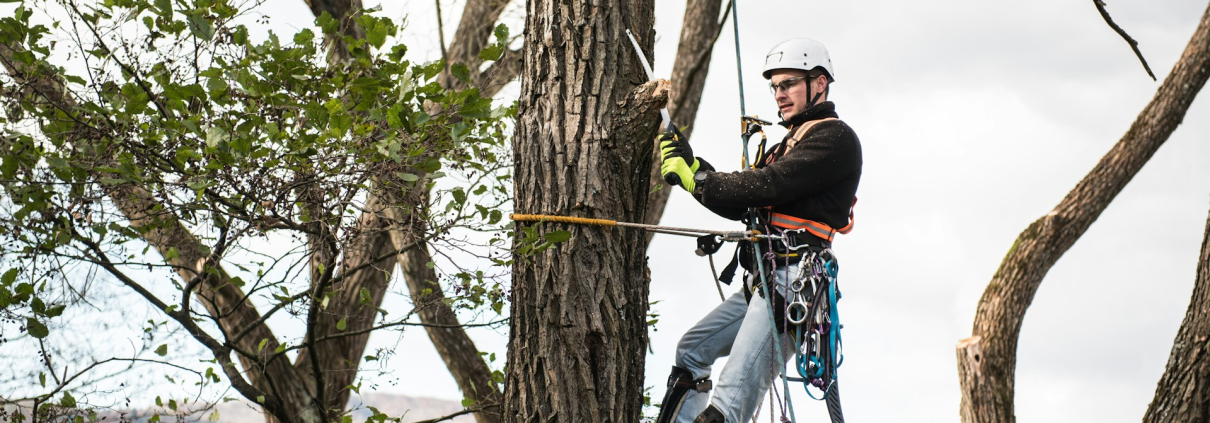Why Tree Pruning is Necessary for Healthy Growth
Tree pruning is a key part of keeping trees healthy and strong. It’s more than just cutting off a few branches; it’s about giving trees the care they need to flourish. Pruning helps trees by removing dead or damaged branches, encouraging new growth, and improving the tree’s structure. This process boosts the tree’s appearance and overall health.
Understanding when and how to prune makes all the difference in tree care. Different trees may need different types of pruning to ensure they grow properly. With the right techniques, you can help trees reach their full potential, making them an asset to your garden or community. Pruning is essential for trees to thrive; learning about it is the first step in ensuring healthy tree growth.
Understanding Tree Pruning and Its Role
Tree pruning is a fundamental part of tree care, playing a crucial role in a tree’s long-term health and structure. It involves carefully cutting away certain parts of the tree, like branches, to promote healthy growth and maintain the tree’s shape. Each cut made during pruning serves a purpose: to remove dead or diseased wood, improve light and air circulation, or manage the tree’s size.
One of the primary roles of pruning is to eliminate dead, damaged, or diseased branches. These parts of the tree can act as entry points for pests and diseases that may spread to the rest of the tree. By removing them, you reduce the likelihood of infections and infestations. This preventative measure helps ensure that resources like water and nutrients are used efficiently by the healthier parts of the tree.
Pruning also helps manage the tree’s growth by promoting a strong structure and reducing the risk of storm damage. Proper pruning can encourage trees to develop a sturdy branch framework, essential for standing up to strong winds and heavy rain. Overgrown branches can be hazardous, sometimes leading to breakage and potential damage to property or injury to people.
Benefits of Pruning for Tree Health
Pruning offers several significant benefits for the overall health of a tree, playing an integral role in its vitality and longevity. Here are some key benefits that make pruning a necessary practice:
- Disease Prevention: Removing dead or infected branches stops the spread of disease within the tree. This early intervention helps keep the tree healthy and reduces the need for chemical treatments.
- Improved Sunlight and Air Circulation: Pruning opens up the canopy, allowing more sunlight and air to reach the interior parts of the tree. This reduces moisture, which can help prevent fungal infections.
- Enhanced Growth: By cutting back overgrown branches, more resources are available for the remaining parts of the tree. This can lead to more robust and vigorous growth, especially in young trees.
- Structural Strength: Regular pruning encourages a strong branch structure. It reduces the risk of broken branches, especially during storms, enhancing the tree’s ability to withstand adverse weather conditions.
- Safety Improvements: By removing weak or heavy branches, pruning reduces the risk of falling branches, which can cause accidents or damage.
- Aesthetic Appeal: Well-pruned trees look tidy, enhancing the landscape’s visual appeal. They add to the beauty of parks, gardens, and streets, contributing to a pleasant environment.
Techniques for Effective Tree Pruning
Effective tree pruning requires the right techniques to ensure healthy growth and development. Several methods are available, catering to different tree needs and circumstances.
- Crown Thinning: This technique involves selectively removing branches to reduce the density of the tree’s crown. It helps sunlight and air penetrate through the canopy, reducing disease risk. Thinning should maintain the tree’s natural shape while removing overcrowded branches.
- Crown Raising: By removing the lower branches, crown raising increases clearance from the ground. This method is useful for trees near paths, roads, or buildings, ensuring that branches don’t obstruct views or cause hazards.
- Crown Reduction: This is used to reduce a tree’s height or spread. It is achieved by cutting back branches to a secondary growth point. Crown reduction should not drastically alter the tree’s shape but is ideal for managing trees that grow too large.
- Deadwooding: Removing dead or dying branches is essential for tree health. This technique focuses on trimming away branches that no longer contribute to the tree’s well-being, preventing disease and pest problems.
- Pollarding: This technique manages tree size and shape by cutting branches to the main stem or trunk. Pollarding promotes new, healthy growth and is often used for trees lining streets or shaping out of necessity.
Identifying the Right Time for Pruning
Timing is crucial when it comes to pruning. Knowing when to prune can enhance growth and prevent damage, ensuring trees remain healthy throughout the year.
Dormant Season Pruning: Most trees benefit from pruning in the late winter or early spring when they are dormant. Without leaves, it’s easier to see the tree’s structure and make precise cuts. Pruning before the new growth period allows trees to recover quickly as they start growing.
Summer Pruning: Removing dead or diseased branches in the summer can be beneficial for some trees. This time is ideal for controlling the growth of trees that have expanded too much during spring. Summer pruning helps regulate size and remove branches that could be harmful if left until winter.
Flowering Trees: The timing for pruning them depends on when they produce blossoms. Trees that bloom in early spring should be pruned after their flowers fade. This timing ensures you don’t remove buds unnecessarily. Pruning in late winter or early spring is best for trees that flower in midsummer.
Avoid Autumn Pruning: Pruning in the autumn can lead to poor healing and increased vulnerability to disease. As trees prepare for winter dormancy, cutting branches can stress them, leading to problems during the colder months.
Conclusion
Tree pruning is vital in maintaining healthy, safe, and attractive trees. By understanding the correct techniques and timing for pruning, you can significantly improve the lifespan and health of your trees. The right approach to pruning enhances a tree’s natural beauty and prepares it to withstand various environmental stresses. Whether you’re thinning a crowded canopy or removing dead branches, every cut is an opportunity to guide the tree towards a stronger structure and healthier growth.
For expert guidance and efficient tree maintenance, TPS Tree Services offers professional solutions tailored to your needs. Our team can assess your situation and provide precise tree pruning in Brisbane that keeps your trees thriving. Contact TPS Tree Services today to ensure your trees are pruned correctly and maintain their splendour for years.




